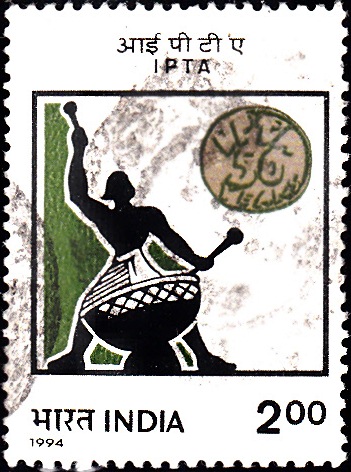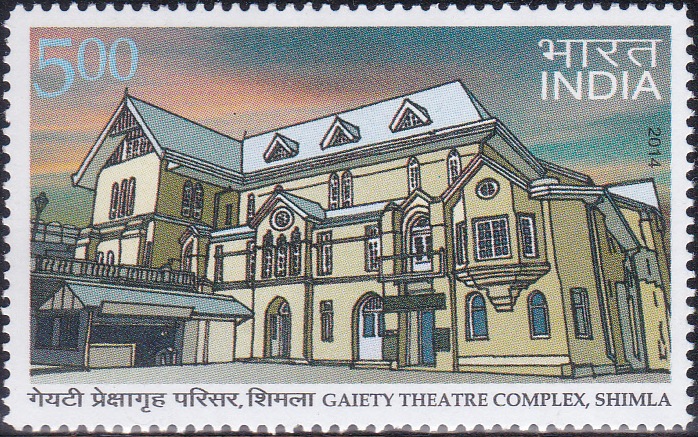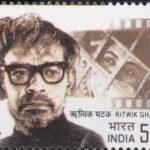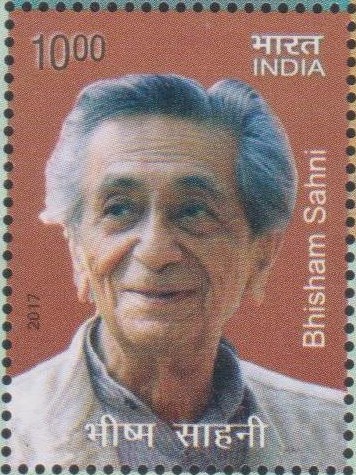
Indian People’s Theatre Association
A commemorative postage stamp on the 50th Anniversary of the IPTA, oldest association of theatre-artists in India :
 Issued by India
Issued by India
Issued on May 25, 1994
Issued for : The Department of Posts, is privileged to bring out this commemorative postal stamp on the occasion of the Golden Jubilee year of the IPTA.
Credits :
Stamp, FDC and Cancellation : Smt. Alka Sharma, Artist, Deptt. of Posts. (Source: IPTA).
Type : Stamp, Postal Used
Colour : Multi Colour
Denomination : 200 Paise
Overall size : 3.91 x 2.90 cms.
Printing size : 3.55 x 2.54 cms.
Perforation : 13 x 13
Paper : Indigenous Un W/M Adhesive Gravure Coated Stamp Paper in Sheets of 50.8 x 53.5 cms.
Number of stamps Printed : 1 Million
Number per issue sheet : 35
Printing Process : Photogravure
Printer : India Security Press
About :
- IPTA – or the Indian People’s Theatre Association was one of the products of the political ferment of the ‘40s. India’s struggle for freedom was not waged for merely economic or political gains – in a very important way, it was to reassert India’s cultural identity.
- A People’s Theatre Movement was started by a few intellectuals, scientists and artists at Bombay in the years 1942-43, and was christened IPTA by late Homi Bhabha. This theatre group was a movement which gave expression to the agony of the Bengal famine in the heart-rending song ‘BHUKA HAI BENGAL’ led by Harindranath Chattopadhyay. Within a short span of time, 500 units of IPTA sprang up all over the country combining the dynamism of Punjab, The lyricism of Bengal, and the pain of rural Assam and Andhra, and welded all these on to a common platform. Dr. Sarojini Naidu, known as the nightingale of India, became its first President. Pandit Jawaharlal Nehru, who was greatly impressed by IPTA’s approach, had this to say about it :–
“I am greatly interested in the development of a people’s theatre in India. I think there is a great room for it provided it is based on the people and on their traditions. Otherwise it is likely to function in the air.”
- Ever since, IPTA has developed a truly national cultural character and has concentrated on themes that concern the common man. These themes have been presented through the traditional forms of art to have a broad mass appeal. IPTA has also presented ballets, songs and dramas on communal unity. Traditional folk arts have been revived and new forms given to community music and dances of the hill tribes. The IPTA has been the pioneer of the street theatre movement in India.
- IPTA has in the recent years been endeavouring in the direction of stressing the basic cultural unity of the country and in its Golden Jubilee year has organised a unique march, ‘YATRA’ from Varanasi to Meghar. IPTA has attracted talented actors, dramatists and musicians, and continues to be an independent cultural movement working towards social development and national integration.
- Text Source : IPTA.








I shall be happy to be a member of IPA
[…] sensitivity to the myriad forms of socio-economic oppression grew ever more acute. He joined the Indian People’s Theatre Association (IPTA) and made the astonishingly assured, bravely path-breaking film, ‘Udayer Pathey’. The […]